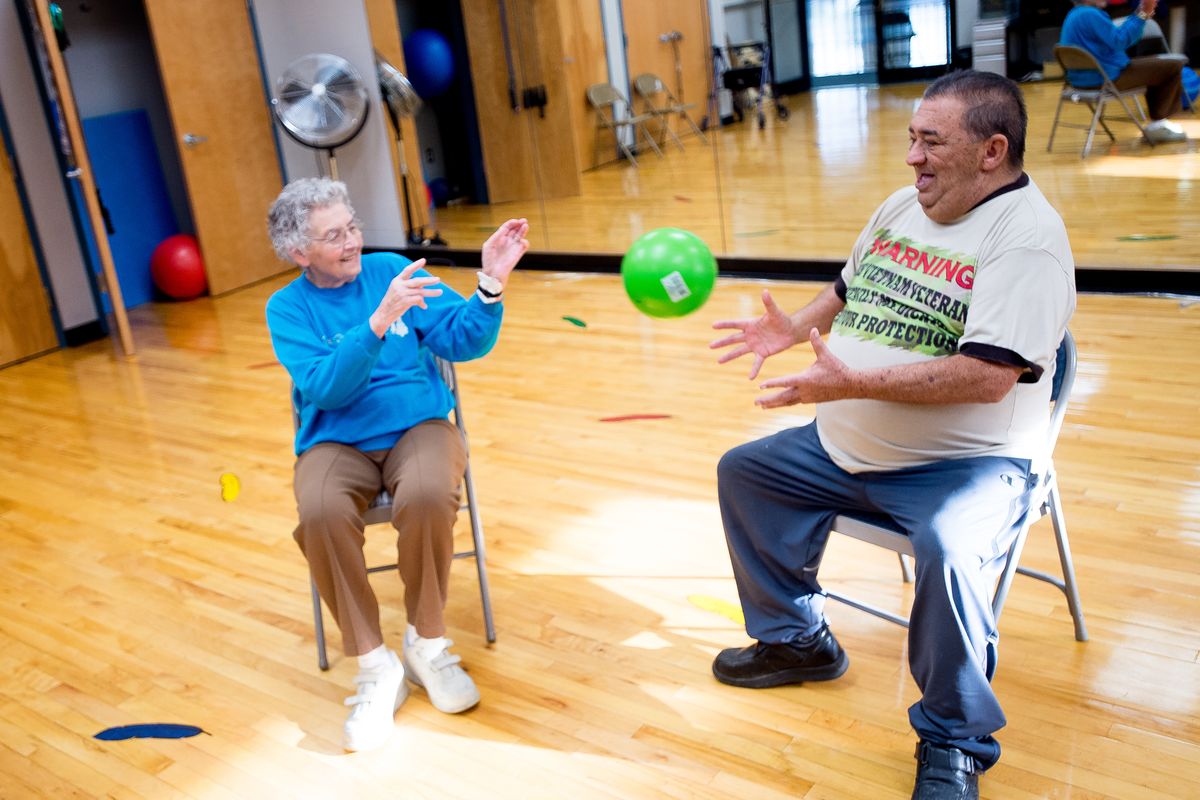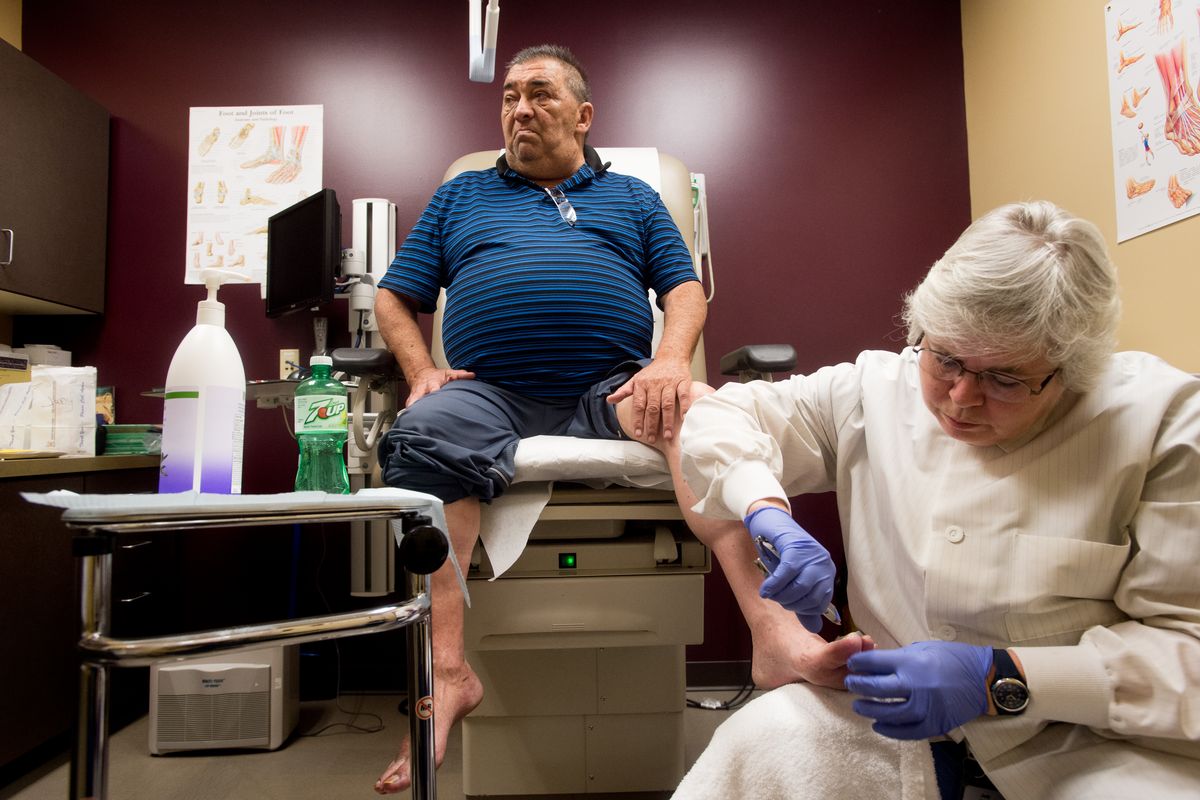‘Turning the tide’: Coeur d’Alene Tribe taking proactive approach to diabetes
Perry Kitt has his feet examined by Judy Gordon an RN and certified diabetes educator on Tuesday, Feb. 3, 2015, at Benewah Medical Center in Plummer, Id. Maintaining feet is crucial for patients like Perry, Gordon said. "Preventing amputations is huge. (Tyler Tjomsland / Spokesman Review)Buy a print of this photo
PLUMMER, Idaho – Perry Kitt arrived at the Benewah Medical Center for his foot care appointment – a regular stop for the Coeur d’Alene Tribe elder and diabetic. “How are your feet doing?” said Judy Gordon, a registered nurse and certified diabetes educator. Kitt, a 70-year-old Vietnam War veteran who grew up in DeSmet, answered, “I can’t see them. I’m too fat.”
Joking aside, he described what’s bothering him lately: a muscle in one leg hurts when he steps forward. Gordon talked with him about compression socks, clipped his toenails and applied lotion.
Keeping the feet healthy is crucial for patients like Kitt, she said. “Preventing amputations is huge.”
The community health center operated by the Coeur d’Alene Tribe treats about 400 diabetics, who make up roughly 7 percent of the center’s patients.
The disease is far more prevalent among American Indians. The likelihood of a diabetes diagnosis is about 7 percent for non-Hispanic white adults, but about 16 percent among Indians and Alaska native adults, according to the U.S. Centers for Disease Control and Prevention. And Indian youth ages 10 to 19 are nine times more likely to be diagnosed with Type 2 diabetes, reports the National Institutes of Health.
The medical center, which serves Indian and non-Indian patients in Benewah County, has responded with aggressive prevention and treatment programs.
“We’re screening a lot more now than we’ve ever done before” to determine who’s at risk, said Carla Patterson, a registered dietitian and certified diabetes educator.
The staff screened about 600 people last year, catching them as they cast votes for community leaders, collected their quarterly tribal revenue dividends, and attended cultural and sporting events. The screening entails a short questionnaire to determine if someone falls into the pre-diabetic range and help them confront the disease sooner through diet, exercise and medication.
“We’re trying to get them in to get a diagnosis earlier,” Patterson said. “Because some people don’t realize they’re walking around with diabetes or with pre-diabetes.”
About 100 people gathered Friday at the Coeur d’Alene Casino for the tribe’s annual Diabetes Day Camp. Casino CEO Dave Matheson said his parents and grandparents saw diabetes as a hopeless battle, but today’s generation knows better.
“It all came from the change in diet,” Matheson said. “If we can use this power of the mind to change our habits and to teach our children and grandchildren healthier eating habits, they can enjoy life.”
Psychologist Darryl Tonemah, an American Indian who lives near Niagara Falls, New York, told the crowd he exercises with his children to show them “that this native family is putting up a fight.”
He challenged those in the audience to also be symbols of change for their loved ones.
“We can start turning the tide against diabetes,” Tonemah said.
Reviving traditional food
People living in the Plummer and Worley areas have limited choices for healthy food. The convenience stores and fast-food outlets lining U.S. 95 are heavy on processed foods high in fat, salt and sugar. Not everyone is able to travel to Spokane or Coeur d’Alene for their grocery shopping.
The tribe-owned Benewah Market in Plummer is making some changes, adding fresh produce and a sandwich shop “so there are options other than just fried chicken and JoJos,” Coeur d’Alene Tribe spokeswoman Heather Keen said.
This summer, a “healthy checkout lane” featuring fruits, vegetables, water, milk and nutritious snacks will be added at the Benewah Market and inside the tribe’s Conoco convenience store near the casino.
“If you go there, your kids are going to cry for healthy food and not candy bars – that’s our goal,” said LoVina Louie, coordinator of a tribal project called “hnqhesnet,” a native word that means “it is our well-being.”
The project received a three-year, $1.9 million grant from the CDC’s Racial and Ethnic Approaches to Community Health program.
“We’re creating access to healthy, traditional foods and access to physical activity, with a cultural emphasis,” Louie said.
They hosted a pair of gardening workshops recently, and about 40 people attended and left with materials to build their own garden boxes.
“We feel like if we can help people grow their own food, then we’re creating access,” Louie said. “You don’t have to go to the store to buy it. You have it in your yard.”
In another initiative this month, six families went on excursions to dig camas, a lily-like plant whose bulb was a staple of Northwest tribes.
“We’re trying to get people to go out and go camas digging again and eat our traditional foods – deer meat, elk, buffalo, bitterroot, huckleberries – all our original foods,” Louie said. “It isn’t practiced anymore, so we have to reteach and re-intrigue everybody.”
Those efforts are building on the work of the 7-year-old One Sky/One Earth Food Coalition, a partnership of the tribe and the University of Idaho Extension Office in Plummer. The goal is to make it easier for residents to make good food choices on the reservation and nudge tribal culture away from fast and easy eating habits that contribute to obesity.
The coalition has hosted community dinners featuring healthy dishes and conversation about food and health. It has held an annual lentil and bean cook-off; started community gardens in Worley, Plummer and DeSmet; and organized a weekly farmers market in Plummer. It also has taught healthy cooking to children at the Coeur d’Alene Tribal School in DeSmet and at schools in the Plummer-Worley School District.
The hnqhesnet project also has a physical activity component. Starting in early May, a series of “powwow readiness” classes will be offered at the Coeur d’Alene Tribal Wellness Center in Plummer. It will combine aerobic exercise to powwow songs with stretching and weightlifting to prepare people for dancing at powwows.
“You don’t have to be a powwow dancer. It will just be a different kind of exercise class,” Louie said.
Back from the brink
Encouraging people of all ages to be more active is a vital part of the diabetes prevention and treatment efforts on the reservation.
The wellness center hosts “Get Up and Go” classes three mornings a week for elders and people with chronic illnesses. Participants focus on simple activities of daily living, such as getting on and off a stool, catching a ball and walking on varied surfaces. The community health staff also organizes monthly activities like fun runs and Zumbathons.
The wellness center, open to enrolled members of the tribe and the community at large, has a swimming pool, basketball courts, weights and exercise machines. Peter Mahoney, the lifestyle balance coach at the medical center, works with patients to get them to commit to regular exercise.
“So we do everything we can to find ways to break down those barriers,” said Mahoney, who has a degree in exercise science. “There’s a couple of patients that I bring down to the wellness center in the morning so they can get their workout in.”
Those who take a 16-week diabetes prevention course called Native Lifestyle Balance ramp up to 150 minutes of exercise each week.
“We don’t like to focus on going to the gym and lifting weights or running. That’s fine if you want to do that, but we want people to realize that anything that gets them up and moving – walking the dog, cleaning the house, gardening – that’s all physical activity,” Mahoney said.
For many, though, it’s a struggle to find the time and energy to stick to an exercise regimen.
“They have kids; they have a job,” he said. “As soon as they get home, they don’t want to get up and do very much.”
One tribal member’s journey back to health is inspiring others in the community.
Andy Kitt, the son of diabetes patient Perry Kitt, had grown heavier and heavier throughout his childhood after he was hit and seriously injured by a drunken driver when just 4 years old.
A few years ago he topped out at 559 pounds. That winter he slipped on the ice and broke his kneecaps.
“I realized that nobody would be able to lift me off the ground,” said Kitt, 29. “I decided from that point on I needed to do something to lose this weight.”
Kitt told his doctor he wanted to live for his family, for himself. The medical and wellness staff put together a program for him that spring.
“A lap around the gym is all I could do” at first, Kitt said. But “the weight just started slowly coming off.”
After two years, he had shed 205 pounds. But he gained back about 30 pounds after his mother died of a heart attack in 2013 and he was dealing with grief and stress from the loss.
Now Kitt is back to working out one hour a day, five times a week, plus watching what he eats. He exercises at the wellness center, where he also works as a fitness specialist and lifeguard.
His goal is to slim down to 270 pounds.
But Kitt worries about the health of so many others on the reservation. Like his dad, his mom had diabetes, as does one of his sisters.
“I have relatives and family, young cousins, that are overweight,” Kitt said. “They really need to get in here and start working out.”
Combination of programs is paying off
The medical center’s emphasis on screening, diagnosis, prevention and treatment is paying off.
Almost 61 percent of the diabetes patients there successfully managed the disease, hitting blood-sugar targets over time, according to a 2014 report to the federal Indian Health Service. That’s up from 48.6 percent of patients in 2010 – a trend that officials attribute to greater emphasis on medication, diet and exercise, although the standard blood-sugar target also was raised in that period.
Only 58 percent of Indian patients kept their blood sugar in the controlled range in 2014, compared with 65 percent of the medical center’s self-identified white patients. But Indian patients whose blood sugar was way out of control has come down: from 17 percent in 2001 to 6 percent in 2013, according to the center’s diabetes audit reports.
Insulin use in that same 12-year period went from 9 percent to 47 percent among Indian patients. Doctors today are much more likely to prescribe insulin to patients to help bring blood sugars down more quickly, according to medical center staff.
Sharon Pakootas, of Plummer, said she has struggled to adapt to diabetes since her diagnosis in 1988.
“I’m surprised I even lived this long,” the 65-year-old tribal member said with a laugh.
Pakootas, who retired from working in the tribe’s human resources and enrollment offices, estimates about half the tribal members she knows have diabetes. Her former husband had it, as did her father and sister. Her son is diabetic as well.
“It’s just strange to see that so many people are diabetics,” she said. “It could be because of the food that we were brought up on, you know, the potatoes. I just found out like last week that corn is a carb that has sugar in it, and I just love corn.”
That’s how it has been for her – a never-ending learning curve on what to eat, what to avoid, and how to find the right balance for good health. Complicating matters is her high blood pressure and anemia. She takes a dozen prescription medications a day.
“The pills and the insulin, that’s my life right there,” Pakootas said. “So I have to take it if I want to live, and that’s kind of scary.”





